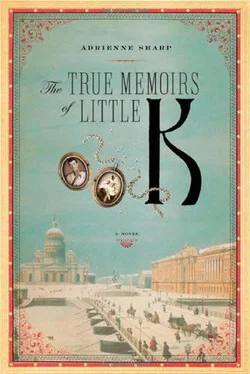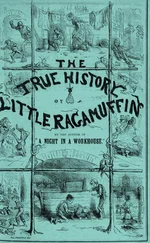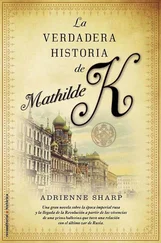. The officers on horseback used to follow the coaches stuffed with girls as we traveled from the school to the theater—a tradition that dated back decades to even before the Maryinsky was built, when the coaches took the girls to the old Bolshoi Theater on Theater Square, where my father danced before it was razed—calling out to us and asking our names, which our chaperones forbade us to give, though we wanted to. I had to put my hand over my mouth to keep my name from spilling out:
Mathilde-Maria . To keep us pure and to protect us from the syphilis that plagued the capital, we were sequestered from all outside influence—and equally sequestered from the schoolboys. Girls were penned together on the first floor of the school, boys on the second. Separate dormitories, schoolrooms, rehearsal rooms, dining rooms. We knew the boys existed, of course, for during ballroom class we practiced with them the minuet and quadrilles, where we were forced to touch, but we were not permitted to look into each other’s eyes while doing so. The governesses watched us closely and they would swoop in to scold at any sign of forward behavior. Our day clothes were laughably modest, the dresses full of buckles and over-laid with aprons, and beneath our skirts we wore long, dark stockings; our practice clothes were a knee-length version of a street dress; our fur-lined coats were so dark and sober we called them penguins. And we looked like penguins in them, waddling around and around the courtyard—the only freedom we were allowed. We couldn’t play wildly—no bicycles or balls, no ice sliding or ice-skating, no toy swords for the boys. We were property of the Imperial Ballet and if we were injured we were of no use to it and the money spent on us gone to waste. At lunch and supper the governesses counted us off two by two as we lined up for the dining hall. At night the other students slept in a single vast room of fifty or more beds, each bed dressed in white like the coffin of a child, and at the head of each bed a small table with an icon and the school number of each girl.
Why all the numbers, all the counting? To ensure that what had happened to a girl of some years ago did not happen again. Her elopement with an officer of the Horse Guards had made a fantastic scandal. Each afternoon she found some excuse to stand in the window of the dormitory and watch him ride by, a far too glamorous spectacle to be borne, in his white uniform and silver helmet, and driving two bay horses. He had to have been a spectacle, for Theater Street was normally empty of traffic except for the vast old-fashioned carriages that conveyed us students about. That he paraded unnoticed across the Anichkov Bridge and along the back side of the Alexandrinsky Theater must be myth, and in that myth, of course, his beloved had to be beautiful, very beautiful—girls in these kinds of stories are always beautiful, like princesses. So one afternoon she borrowed a maid’s shawl—yes, the princess disguised as a peasant—and slipped out a side door into her future, which I hope was bright. And since her wedding day no girl older than fifteen was allowed home for a holiday other than three days at Christmas and Easter Sunday itself.
I myself was not a boarding student. My father was an Honored Artist of the Imperial Theaters, invited to St. Petersburg by Nicholas I, who loved dancers massed on the stage almost as much as he loved bayonets massed on the parade ground. And my father used his influence to spare me that spartan school life, so at odds with the ebullience of the actual theater we would soon serve. He didn’t want my spirit broken. And perhaps that was his mistake.
_______
Nevertheless, whether we lived at home or at school, our virginity was carefully guarded until our graduation day, when it was then offered up. Sewn into costumes that exposed our necks, our arms, our bosoms, our legs, we decorated the stage for the pleasure of the court, all those aristocratic balletomanes who handed down to their sons their subscriptions along with their titles, who sat in the boxes and first stalls of the Imperial Theaters for the best views and aimed their lorgnettes or opera glasses at us. In the smoking rooms, at the intervals, they debated our merits. It was a reciprocal attraction. We needed protectors to advance our careers and to supplement our miserable salaries with dinners, gifts, wreaths, and flowers. And as our costumes imitated the dress and jewels of the court, so we developed a desire to possess the silks and velvets we wore for a few hours each day, the gold that embroidered those fabrics, the gems to which our colored glass aspired. There were many girls at the school who came from nothing—why, Anna Pavlova was the daughter of a laundress—and whose liaisons could help the fortunes of their families. This was a long-standing tradition. Count Nikolai Petrovich Sheremetiev, in the eighteenth century—back when each nobleman had at his country estate his own theater and his own serf opera company, ballet company, orchestra—made a mistress of one of his opera singers and then secretly married her. In my time the grand dukes Konstantin Nikolaevich and Nicholas Nikolaevich, uncles of Tsar Alexander III, each kept a mistress from the ballet, and of Nicholas Nikolaevich’s illegitimate children with the ballerina Chislova, the boy served in the Life Guards Horse Grenadiers and the girl married a prince. Sometimes these protectors married the girls they had made their mistresses and these girls became matriarchs of some of the greatest aristocratic families of Russia. Kemmerer, Madaeva, Muravieva, Kantsyreva, Prihunova, Kosheva, Vasilieva, Verginia, Sokolova, all were ballerinas of the 1860s and earlier who married noblemen. This possibility, rather than a reverence for the art, motivated many mothers to take a pretty child or a graceful one to the auditions on Theater Street. But some of us, of course, remained only mistresses.
The imperial wives saw to our suffering, you can be sure of that, even if a man’s mistress came from the court itself, from a noble family. No matter. When Niki’s grandfather Tsar Alexander II was murdered, his second wife—long his mistress, and no Romanov woman forgot those years—was barred from his funeral! Unfortunately, he died before he could make her his empress and legitimize the positions of his children by her. And so at his sudden death his first family moved immediately against her. The family would have taken her title of princess from her if they could. And what of this was her fault? She was seventeen to the emperor’s forty-seven when she met him strolling in the Summer Garden, with its four long avenues leading to the Neva, its linden trees and its maples making green walls through which filtered the wet scent of that water, its wrought-iron fences barring as it should dogs, muzhiki , in their bright-colored shirts and high boots, the working class, and Jews. Who asked the young Ekaterina to wait for him in a secluded ground-floor room of the Winter Palace? Who gave her children? Who eventually moved her into that palace? She was a Dolgoruky, the daughter of a prince, from one of the oldest aristocratic families in Russia, and still the women of the court labeled her a schemer, a fornicator, a social climber. Imagine what they would say of me.
She was seventeen, a girl walking in a park east of the Champs de Mars.
And so was I seventeen. And that next week after graduation, in my best clothes, my hair curled in the fashion of the time, I walked not in the Summer Garden, but along Nevsky Prospekt, anxious to follow up my first meeting with Niki with another, during the great afternoon promenade that began each day after lunch and ended before twilight, at which time the workmen would drag their ladders from street to street, lighting each gas lamp by hand, before the evening’s salons, parties, dinners, and balls.
Читать дальше












